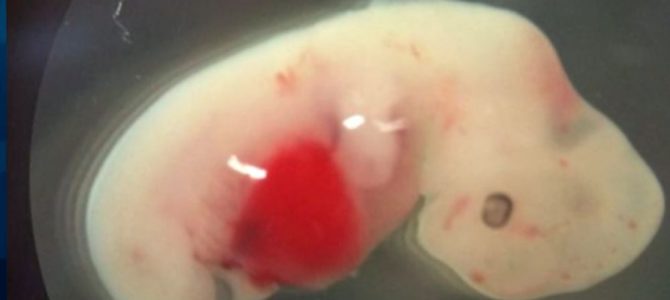
With the news cycle understandably focused on the early Trump administration, an important non-Trump story did not received the attention it deserves. Recently, researchers created a human-pig hybrid. This creature is called a “chimera”—a name, as Merriam Webster says, taken from a monster in Greek mythology that was part lion, goat, and serpent. The research was published in the journal Cell, and reported in National Geographic and ScienceDaily.
To create this chimera, the researchers fertilized a pig embryo then inserted human stem cells. The human cells were pluripotent stem cells, meaning they can develop into cells of any type. For example, given the right conditions, a pluripotent stem cell could develop into a neuron, a heart-muscle cell, or a skin cell.
So, the human stem cells combined with the pig cells, creating a single human-pig creature, albeit with many more pig cells than human cells. The researchers allowed the chimeras they created to gestate in a pig for three to four weeks before terminating them for further study.
The researchers’ some-day goal for this line of research is to end the need for organ donation. Say a patient suffers from kidney failure. If the chimera research sufficiently progressed, then a doctor could simply harvest cells from that patient and combine them with a pig embryo to make a sort of personal chimera.
The chimera would then gestate, be born, and grow into adulthood, hopefully at the accelerated pace of pigs. If the research met our hopes, the now-adult chimera would have fully human organs of the same genetic makeup as our patient. The chimera’s kidneys would then be harvested and transplanted to our patient, who could then expect a full recovery.
The immediate benefits over organ donation are obvious: no wait (and thus no patients dying on organ-donation waiting lists), much lower coordination costs (because the chimera’s organs could be harvested at a predictable time and place), and no chance of organ rejection by the patient’s body (since the organs would be genetically matched to the patient).
Let’s Tilt the Experiment a Bit
But putting aside this progress and potential for a moment, our researcher friends seem to have given short shrift to preliminary question. Imagine, instead of announcing they have created a mostly pig chimera, our researchers had announced the creation of a chimera comprising a single pig cell in an otherwise all-human-cell body. They then detailed their plan to gestate this mostly human chimera for nine months, mature it for 18 years, and then to promptly harvest its organs.
Such an announcement would not be warmly received. Indeed, I expect we would respond with condemnation. If this expectation were true, then it seems we should have answered the following question before we traveled down the chimera rabbit hole: how much of a human can a creature be before it is a human?
This is not an angels-on-the-head-of-a-pin question: The mostly pig chimeras our friends actually created were treated like animals. They were gestated in a pig, deliberately killed after roughly a month of development, dissected for study, then discarded. Moreover, the destiny of their “descendants” is to have their organs harvested by us and solely for our own benefit. In contrast, the hypothetical mostly human chimera could not be treated in like manner without someone committing several felonies. Therefore, drawing the correct line between these two creatures is of grave importance.
We Need a Criteria for Determining Human Versus Animal
Yet to draw this line, we cannot simply rely on the number of human cells in the chimera—as in, the more human cells the creature has, the more human it is. In other circumstances the mere number of cells in a creature doesn’t make it more or less of what it is. A fertilized human egg is an individual human, despite the fact that this human is, for a short time, only one cell.
The principle works for born humans too. If a child grows six inches taller, or a soldier suffers the misfortune of losing a limb, they don’t become more or less human, respectively. What meaningful criterion compels us to treat the chimera’s case differently?
We also cannot rely on the sheer percentage of human cells that make up the chimera—that is, if 51 percent of the chimera is human, then it is a human. What if at one stage of the chimera’s development it is composed of 50 percent of human cells, but at a later stage—say, right before we harvest its organs—that number grows to 51 percent? Was the chimera not a human at the early stage, but was a human (although perhaps an inconvenient one) at the later stage?
In any event, what if 51 percent human composition were the threshold required to make the chimeras useful? The researchers plainly admit that they need to create chimeras with many more human cells—indeed, with fully human organs—in order to solve the organ-donation problem.
Finally, we can’t draw the line based on the type of human cells that make up the chimera—that is, if the chimera does not have a brain made of human neurons, then it’s not human. A newly fertilized human egg doesn’t have a brain, yet it is still a human. So it can’t be true that “real” humans are actually just human brains in organic jars called bodies. (Also, remember the human cells in the chimera were pluripotent stem cells; these cells can develop into any type of cell in the body, including neurons.)
We Need to Know Before We Move Forward
Candidly, I’m not convinced that the mostly pig chimera was actually a human, although I am convinced that my hypothetical mostly human chimera would be a human. Nevertheless, I am unable clearly define the line separating these two creatures, and it unfortunately seems our friends haven’t defined it for us either.
When we are faced with such a grave question—“When exactly is the object of our manipulation a beast and when is it a brother?”—acting before answering is not the correct response, even when the benefits are extraordinary.
One of the researchers commented on this scientific breakthrough by noting that, “[i]n ancient civilizations, chimeras were associated with God . . . the chimeric form can guard humans.” Perhaps that’s a true interpretation of ancient mythology, but let’s speak plainly: The chimeras we create in our labs would not be our guardians. They would either be quasi-miraculous organic medical devices, or they would be our slaves. Discerning which of these two options we are dealing with is absolutely essential, even for researchers that don’t have moral objections to mixing human and animal.








